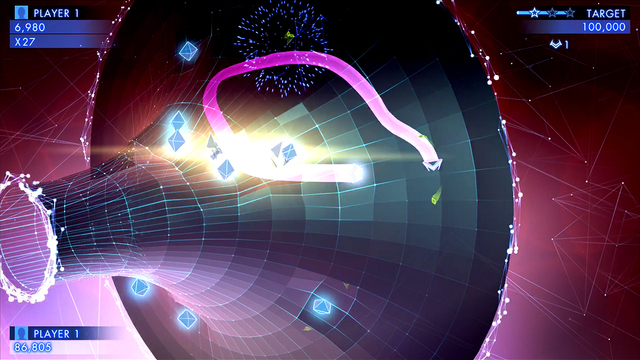

These secondary abilities are generally offensive in nature, deploying homing missiles or black holes to clear out enemies in sticky situations. For example, the “Ram” drone is able to seek out and crash through enemies, and the “Attack” drone more or less functions like a secondary gun, which is useful in various boss encounters.ĭrones are then modified by combining them with a Super. Abilities and usefulness vary by the drone in question. I went with the “Collect” drone, which flies around the map collecting geoms while my focus stays on taking out enemies. The drone serves as your companion ship and perform differently depending on the model chosen, each seemingly geared geared toward different styles of play. Loadouts start with the selection of a drone. Loadouts are another one of the major changes introduced in Dimensions. One level in particular features two halves of a sphere split down the center, requiring you to bounce back and forth through a central portal to take out enemies and drive up your score before time runs out. This is more the case on the on the more cylindrical playfields, such as the pill or peanut-shaped stages, than the spherical or cubic ones, which are thankfully few and far betweenįor every miss, though, there are way more hits. Granted, not all of them are hits, and it can be frustrating when the visible area is be really narrow and enemies can pop out from around a corner with little to no time to react, causing a near-instantaneous death and throwing off the whole rhythm of play.
#Geometry wars 3 dimensions evolved best drone series#
While three-dimensional playfields are nothing new for this style of shooter (Housemarque’s Super Stardust series have been doing it for years, as have several others) the extent of the varying level designs is. Dimensions turns the whole thing on its head by literally adding a new level of depth to the levels in its introduction of three-dimensional playfields of radically differing shapes and sizes. In the past, all games have employed a more or less identical rectangular playfield.

Level design in Adventure mode varies on a per-level basis. It can be extremely frustrating being one star short of a new segment and having to go through the same levels over and over, missing the target by a minuscule amount, but the satisfaction of hitting that mark at the very last second is pretty fantastic. Sure, you can breeze through a level and get one or two, but the progression is gated in such a way so that in order to unlock boss encounters and move on to the next section, you’ll need to go back and grind out stars. Differing game modes and requirements are doled out on a per-level basis, meaning no one strategy can be employed to just breeze through the game.Įach level has three target scores which grant a star each. The main focus of Dimensions is the newly introduced Adventure mode, a 50-level campaign that rapidly ramps up in difficulty as you advance and requires you to mix up your play-styles to move on. Geometry Wars 3: Dimensions goes in the opposite direction, and quickly differentiates itself from its predecessors by being the first in the series to feature a campaign mode, wildly varying playfields and customizable ship loadouts. Its ever-popular sequels managed to stand out among the sea of noise present in Xbox Live Arcade and helped legitimize the concept of downloadable games in the console space, all the while staying true to the pure arcade-style shooter experience it had been known for. Geometry Wars 3: Dimensions has some really big shoes to fill.įirst introduced as an in-game extra in Project Gotham Racing 2 on the original Xbox , its simple yet refined take on the classic Asteroids-style arcade experience earned it high praise.


 0 kommentar(er)
0 kommentar(er)
